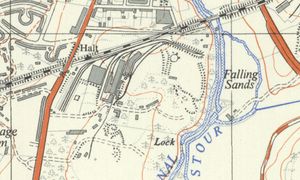Ground Frames at Foley Park
Foley Park is an area of Kidderminster through which the Kidderminster Loop Line runs. The sidings for the British Sugar Corporation’s factory were situated to the south of the line between Falling Sands Viaduct and the Stourport Road Bridge. Access to the sidings was controlled by a ground frame. Ground frames have also been used for other purposes at Foley Park.
Contents
British Sugar Corporation's Foley Park sidings
Access to Foley Park sidings was achieved by a ground frame. A description of the arrangements is contained in this extract from the "Instructions for working to Sugar Beet Factory Sidings, Appendix to Service Timetable, February 1943."[1]
1. The four sidings adjoining the single running line at Foley Park are available for use for traffic purposes
2. The sidings have a connection with the running line, facing from the direction of Kidderminster; the points are worked from a ground frame locked by key on the Electric Train Token for the section Kidderminster Junction – Bewdley South. The site of the connection with the running line at the Sidings is on a short stretch of level; the running line on the Kidderminster side to a point just before reaching the connection is on a gradient of 1 in 112, falling towards the siding, and on the Bewdley side the line rises 1 in 115 in the direction of Bewdley.
3. An intermediate Electric Train Token instrument is fixed in the ground frame cabin for the reception and issue of the Token for the Kidderminster Junction – Bewdley South Section. Telephonic communication with Kidderminster Junction is provided in the ground frame cabin.
The extract from Ordnance Survey Map SO87, surveyed 1938 - 1949, published 1951, shows the layout of Foley Park sidings and the location of the nearby Foley Park Halt.
SVR/BR Boundary
Shortly after BR closed the Bewdley-Kidderminster line in 1970, the SVR acquired the section of the line between Alveley Colliery and Foley Park. Passenger services between Bridgnorth and Bewdley began in 1974, but the only onward traffic from Bewdley through Foley Park to Kidderminster was main line excursions and rolling stock movements under BR control.
In March 1977 Major Olver of the Railway Inspectorate approved the section between Bewdley and Foley Park for SVR passenger use (this normally took place only during galas, as services had to be ‘top and tailed’ due to the absence of a run round loop at Foley Park). To control access between BR and the SVR, two sets of points were moved from Alveley Sidings to Foley Park in early 1977 and installed on the single line adjacent to the sidings to act as trap points, one in each direction.[2]. Two two-lever ground frames were also installed; each controlled a single trap point and associated FPL, with an SVR GF controlling traps in one direction, and a BR GF controlling traps in the other. The ground frames can be seen in this photograph: Link.
Foley Park (2020)
Over the winter of 2019/2020, during track relaying, the SVR took the opportunity to install the refurbished ex-Kidderminster ground frame at Foley Park, in preparation for possible future uses of the site. These include a possible future station serving the Safari Park and developments on the former sugar works site, and the proposed Wagon shed.
The installation of the ground frame was described in the S&T Department's S & T Notes - issue 209. The procedure for operation of the ground frame was described thus:
- The new ground frame at Foley Park Sidings will allow access to the new sidings either out of hours or with the boxes open. For a train to leave the sidings, the Shunter will ring Kidderminster box and ask for a ground frame release. The Kidderminster signalman will send an appropriate bell code to Bewdley South who will reverse his Acceptance Lever. This will provide a release for either the section signal (as now) or the key control instrument. The latter will release an Annett's key at the ground frame to unlock it. Once the ground frame is locked up again, either with the train on the main line ready to depart or locked inside the sidings with the single line section clear, and the Shunter has been advised that all is in order, the Kidderminster signalman will send an appropriate bell signal to Bewdley South either cancelling the train (once it is either locked inside or has arrived at Kidderminster) or intimating it is about to leave for Bewdley. An Up or Down train stopping in section at the sidings would be signalled normally but the Shunter would telephone the Kidderminster signalman on arrival once the train was at a stand clear of the siding points for a ground frame release and then proceed as above[3].
See also
References
- A photograph showing a special train proceeding past the BR/SVR ground frames, C E Steele, 1979. Photograph uploaded to the RMweb forums. Link. Accessed 09/01/2015.
- Great Western Railway Service Time Tables, Shrewsbury, Worcester, Hereford and Newport, July 6th-September 27th 1936. A scanned version of this document available on the website of Michael Clemens - see Link.
- ↑ The Railway at Kidderminster in the 1940s, AJ Turley
- ↑ SVR News 44
- ↑ SVRSig Website: S & T Notes - issue 209
